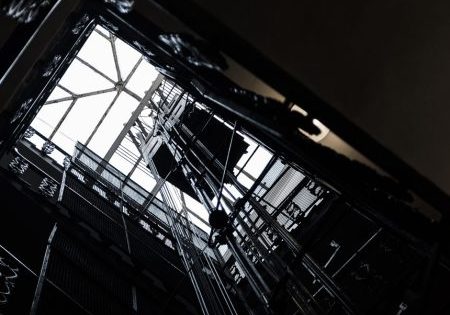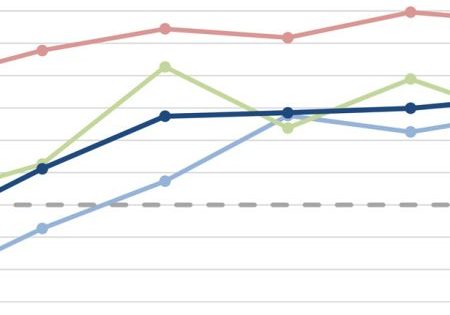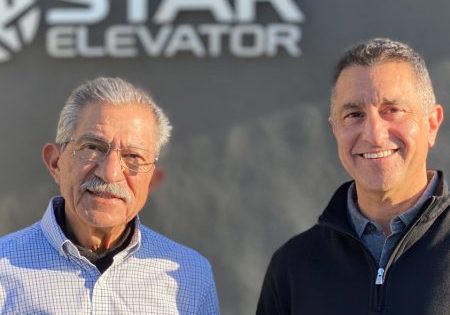California’s Elevator Safety Orders, 1915-1918
Feb 28, 2022

This History article explores a state industrial commission focused on developing safety codes.
In 1915, the Industrial Accident Commission of the State of California launched an ambitious initiative focused on developing safety codes that addressed a broad range of building practices and mechanical equipment — including elevators and escalators. This effort involved establishing a series of subcommittees charged with writing a comprehensive set of safety orders for a given area. In each instance, two subcommittees (working in tandem) were established: one based in San Francisco and one in Los Angeles. The standards writing process designed by the commission was also an iterative one. The elevator subcommittees developed an initial set of “tentative” standards that were published in 1916. Following their publication, a series of public hearings was held, the projects of which were followed by a period of revision and, in October 1916, the publication of the first official set of safety orders. This effort was immediately followed by another round of revisions, which resulted in a third publication that appeared in 1917. The new publication, which included proposed changes to the 1916 orders, was also followed by a series of public hearings, which led to further revisions, and the second edition of California’s elevator safety orders appeared in April 1918. This intense iterative process and the four documents it produced reveal the dynamic nature of code writing in the early 20th century.
The elevator subcommittees, established in mid-1915, included representatives from Building Owners and Managers Associations, the International Union of Elevator Constructors (IUEC), insurance companies, the elevator industry (represented by the Otis Elevator Company), the California Inspection Rating Bureau, the California Industrial Accident Commission, and several iron works (including John A. Roebling’s Sons Company); additional members included an elevator inspector, a building inspector and a member of the Board of Public Works of San Francisco. The IUEC members on the San Francisco committee were Earl A. Stem and Edward W. McGee. Stem served on the initial subcommittee, with McGee as his alternate; in late 1916, McGee replaced Stem on the subcommittee. Both men had served as president of Local Union No. 8. The IUEC representative on the Los Angeles Committee was Horace A. Shurtleff (a member of Local Union No. 18). Otis was represented on the San Francisco subcommittee by engineer Herbert S. Snead, and on the Los Angeles committee by Frank G. Cox (identified as a local manager) and Daniel V. Lever (a construction superintendent). Cox served on the initial subcommittee, with Lever as his alternate; in late 1916, Lever replaced Cox on the committee. The first chair of the San Francisco subcommittee was Dr. Thomas B.W. Leland (coroner of San Francisco County), who was followed in late 1916 by Samuel P. Oppenheim (manager of the David Hewes Building, representing the Building Owners and Managers Association). The first chair of the Los Angeles subcommittee was Frank Cox, who was followed in late 1916 by Daniel Lever. It is of interest that the leadership of the Los Angeles committee was occupied solely by members of the vertical-transportation (VT) industry, while its northern counterpart was led by non-VT industry members (information on the selection process for subcommittee members and committee chairs has, to date, not been found).

In early 1916, the subcommittees published the result of their initial efforts, titled Tentative Elevator Safety Orders.[1] The work included 37 safety orders that addressed a typical range of topics (Table 1). It also included a footnote stating that, beginning with Order 302, “orders referring to both new and existing installations are printed in bold-face type. All other orders refer to new installations only.”[1] This format followed the accepted emerging practice in code writing. This publication was intended to solicit “the criticisms or suggestions of employers, employees and others,” and the publishers noted that “due notice will be given of Public Hearings to be held for consideration of these Tentative Safety Orders.”[1] Only two public hearings were held: one in San Francisco (April 27-28, 1916) and one in Los Angeles (May 11, 1916). In its annual report for the fiscal year ending June 30, 1916, the Industrial Accident Commission noted:
“There was much discussion at the public hearings on the proposed elevator safety orders, and a number of sections were referred back to the committees, after which the commission adopted the elevator safety orders in their final form and set October 1, 1916, as the date on which they would go into effect.”[2]
The Commission’s decision to adopt the safety orders resulted in a second publication, titled Elevator Safety Orders, Effective October 1, 1916. This publication retained the organization of the original draft and included all 37 safety orders, many of which were edited and/or revised, presumably in response to comments made during the public hearings. The orders that received the most attention and suggested revision included cables (hoisting and counterweight), car enclosures, hatchways and penthouses, limit switches, and operation and control. In one instance — the order concerning limit switches — when the tentative order is compared with the revised order, it becomes clear that the authors had been guided toward a much less proscriptive approach:
“Order 330. Limit Switches (tentative order)
(a) All power-driven elevators, except sidewalk-type elevators and dumb-waiters, that are equipped with electro-mechanical brakes shall have substantial hatch limit switches so located in the hatchway as to prevent the over-travel of either car or counterweight, and apply brake when such over-travel occurs. In addition, there must be placed so as to stop the car at the landing directly above the bottom landing a limit switch which may be put into service by turning a rotary snap switch, which at the same time will provide for the illumination of the pit. This snap switch must be located at the bottom landing on the outside of the hatchway adjacent to the door, in a box. (See e)
(b) The key by means of which entrance to the enclosure door is possible must repose in the box containing the Snap switch provided for in (a).
(c) A sign shall be placed in the snap switch box stating that persons desiring to enter the pit must turn this switch before opening the enclosure door.
(d) A sign must be placed on the enclosure door at the lowest landing advising persons desiring to enter the pit to turn the switch provided for in (a).
(e) Where more than one elevator is located in the same hatchway, the control of their limit switches provided to stop the car at the landing directly above the bottom landing shall be by means of a multiple-pole knife switch.
(f) Shipper ropes of all hand-rope control elevators must be provided with limitation stop balls on hand-rope, which will shut off the current from the machine in case of over travel of the car.
(g) All hand-rope control hydraulic elevators shall be provided with stop balls, which shall cut off the supply of liquid to the machine in case of over-travel of the car.
(h) In hydraulic installations where it is not desirable to install limit switches as above, the depth of the pit shall be increased to allow at least twenty-four (24) inches between bottom of pit and underside of car sling frame when car has reached its maximum compression on the bumpers.
“Order 330. Limit Switches (revised)
(a) All power-driven elevators, except sidewalk elevators and dumb-waiters, that are equipped with electro-mechanical brakes shall have substantial hatch limit switches so located in the hatchway as to prevent the over-travel of either car or counterweight, and apply brake when such over-travel occurs. This shall apply to existing installations of passenger elevators.
(b) Shipper ropes of all hand-rope control elevators must be provided with limitation stop balls on hand-rope, which will shut off the current from the machine in case of over-travel of the car.
(c) All hand-rope control hydraulic elevators shall be provided with stop balls which shall cut off the supply of liquid to the machine in case of over-travel of the car.”
However, when it came to hoisting ropes — particularly the methods used to fasten them to counterweights or cars — the subcommittees took a different approach.
The revisions to the original draft enhanced the level of detail included to ensure that ropes were securely attached to their sockets:
“(p) The car and counterweight ends of all cables, except that such fastening is not required for compensating counter-weight cables or for cables of dumb-waiters, shall be fastened by passing through independent tapered and babbitted sockets. The length of socket shall be not less than four (4) times the diameter of the cable. The hole at the small end shall be slightly rounded, with no cutting edges, and its diameter shall be at least one-eighth (1/8) inch larger than the diameter of the cable. The hole at the large end of the socket shall be at least three (3) times the diameter of the cable. The socket shall be of sufficient strength so that the cable will break before the socket gives any indication of distress.
“After passing through the socket the fastening may be made by any of the three following methods:
- Turned in method.
- The strands shall be separated, cleaned with kerosene or gasoline, and turned into the center, the length of the turned in portion being not less than two times the diameter of the cable.
- Turned out method.
- The strands shall be separated, cleaned with kerosene or gasoline, and turned out from the center, the length of the turned out portion being not less than two times the diameter of the cable.
- Straight method.
- Wire shall be bound very securely around the cable and strands opened outward for a distance equal to the length of socket or thimble. Each wire must be separated and cleaned with kerosene oil or gasoline; and shall be dried.
“Wires shall then be brought together and bound at the top. Socket or thimble shall then be pushed over the wires until they are even with the top of socket or thimble. Binding wire shall then be removed and powdered resin sprinkled on the wires inside the fastening. Fire clay or other substance shall then be placed around the cable at bottom of socket or thimble to serve as a shield; Melted zinc shall then be poured into fastening. In place of resin, the following method may be used:
“Dip wires in a solution of one-half muriatic acid and one-half water. Soak wires in this solution for five (5) minutes and then clean off. After this, dip wires in solution weakened by addition of one part more water. To illustrate, if one (1) pint of acid and one (1) pint of water be used, to dilute, add one (1) pint more of water.
“(Do not use solution any stronger than that mentioned.)
“Caution: In using the straight method, it is absolutely essential that the wires be separated and cleaned. If not done carefully, this method of fastening will not prove satisfactory.”
These directives were supported by information included in an appendix titled, “Tensile Strength Tests on Elevator Cables and Fastenings.”[3]
The committees felt compelled to pursue these tests in response to information gathered during the public hearings:
“During the course of the public hearing held in San Francisco on April 27-28, 1916, when the Tentative Elevator Safety Orders were openly discussed, a question was raised as to the most desirable method of fastening elevator cables to the car sling. One person in particular produced considerable evidence to the effect that a poorly fastened cable had been directly responsible for loss of life. Owing to the absence of any conclusive data on cable fastenings, the Industrial Accident Commission of the State of California has conducted tests, and herewith submits data which well merits the attention and consideration of all interested in this work.”[3]
The tests were conducted by Smith, Emery & Company of San Francisco (the company was established in 1904 and is now known as Smith-Emery). They described themselves as “Inspecting, Testing, and Chemical Engineers.” The general parameters for the tests were described as follows:
“In preparing specimens for the tests, particular attention was given to the temperature of the zinc and babbitt, as well as the procedure in turning in, turning out, and straight methods of fastening. Various types of sockets and thimbles were obtained and fastened to both Swedish iron and steel cables. As far as possible, all tests were run in triplicate, so as to obtain a fair average. All fastenings, with the exception of those designated as “Roebling straight” and “Waterbury straight,” were made by a member of the International Union of Elevator Constructors, No. 8, while the Roebling and Waterbury fastenings were made by these respective concerns.”[3]
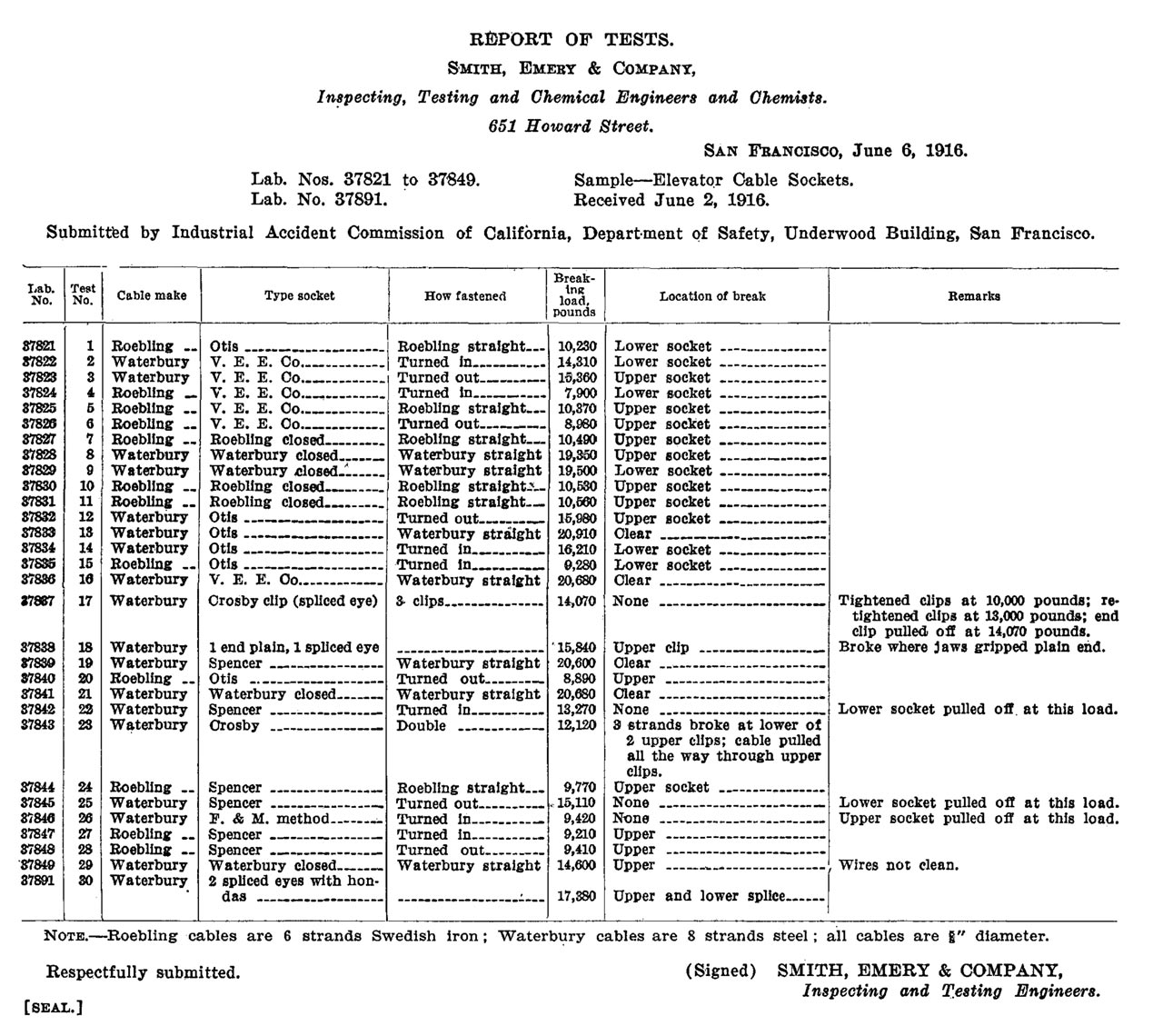
The overall results were reproduced in a table that listed the rope maker, socket type, fastening method, rope breaking load and the location of the break (Figure 1). The appendix also included a series of photographs of rope failures, which had been taken after the sockets had been cut in half (Figure 2). One conclusion drawn from the tests was, essentially, that any of the fastening methods was safe if proper protocols were followed regarding appropriate socket size, wire cleaning and spelter heating (zinc or babbit).
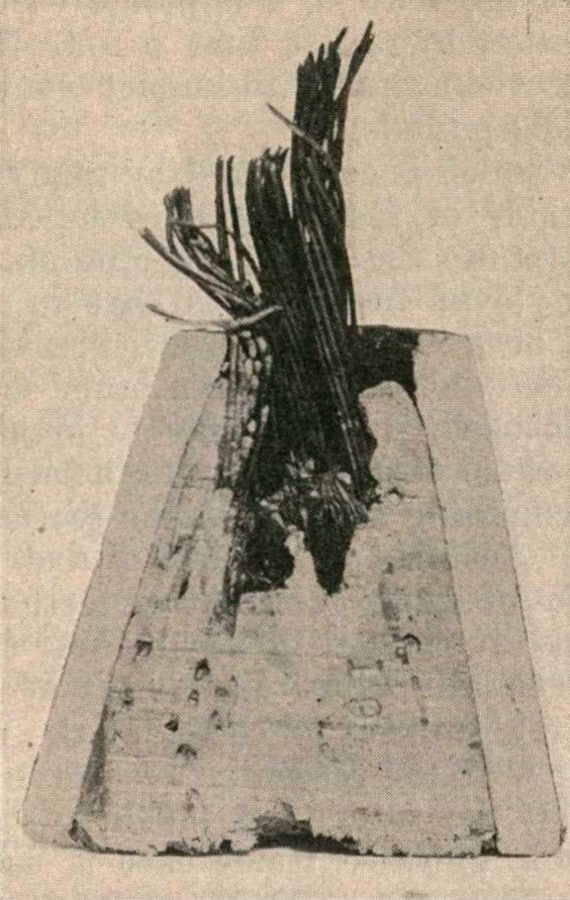
The committee did, however, offer one specific recommendation with regard to determining the factors of safety for hoisting ropes. They recognized that it was “a well-known fact that elevator designers accept the listed ultimate strengths of these cables as being correct, and that they figure the factor of safety on their installations from the listed strengths.”[3] However, the committee felt that “an important conclusion” of the tests was that none of the ropes had reached their “ultimate strengths as listed in the manufacturers’ catalogues” prior to their failure.[3] According to the report, “It appears that the fastenings in the majority of cases weakened the cables rather than that the cables were overrated.”[3] The committee recommended that “It would not seem advisable, therefore, for the elevator manufacturer to figure too close to the factor of safety, but allow a liberal margin.”[3]
While the 1916 safety orders have the appearance of a definitive document, it may have been intended simply as a means of quickly establishing the formal presence of the orders while the committee pursued further changes and refinements. This supposition is supported by the appearance in mid-1917 of a third publication: Tentative Revisions of Sundry Elevator Safety Orders.[4] These revisions included the replacement of the order on inspection with the text of a recently passed state law that superseded the work of the committees:
“(a) Chapter 74, Laws of 1917.
An act to provide for the periodical inspection of elevators operated in places of employment in this state; to require a permit for such operation; to make it a misdemeanor to operate such elevator without such permit; and to provide for an injunction against such operation if dangerous to the life or safety of employees; to vest in the Industrial Accident Commission the power to make such inspections and determine the competency of inspectors and require reports of inspections and to issue such permits and prescribe maximum fees therefor. (Approved April 6, 1917. In effect July 27, 1917.)”
The orders that received the most attention and suggested revision included cables (hoisting and counterweight), car enclosures, car safety devices, hatchways and penthouses, freight elevator doors and gates, and operation and control. The majority of these revisions clarified the previous text and/or added additional requirements. Once again, these tentative orders were discussed and debated in public hearings and, once again, only two public hearings were held: one in San Francisco (October 19, 1917) and one in Los Angeles (October 26, 1917).
Following these hearings, the subcommittees considered the public’s input and concluded their work in early 1918. A comparative reading of the 1917 proposed revisions and the 1918 final draft reveals that the subcommittees made only six minor editorial changes in response to information gleaned from the public. The Commission approved the proposed changes on April 1, 1918. The resulting publication, Elevator Safety Orders Issued by the Industrial Accident Commission of the State of California (Effective October 1, 1916, and as revised, Effective April 1, 1918), served as California’s elevator code until 1925.
The activity associated with the writing of this code, pursued over an approximately 48-month period with, apparently, very few breaks, and which produced four separate publications, serves as a clear indication of the importance of developing effective elevator safety standards. It is also important to place these efforts in a national context. The publication of the results of tests on rope fastening methods marked one of the first times that this type of data had been included in a published code. This possible first was paired with a proposed set of escalator safety standards (which remained unchanged in this process after the first draft) that echoed other efforts to devise rules for this emerging technology. As an example, the definition for “escalator” found in Boston’s 1914 Elevator and Escalator Regulations is almost identical to the definition found in the tentative 1916 California safety orders. Other basic standards and metrics are also consistently echoed in both codes. While much work has been done to explore the world of code makers and code writing, additional work is needed to tell the full — and complex — story of code development in the U.S. (and elsewhere).
References
[1] Tentative Elevator Safety Orders, Sacramento: California State Printing Office (1916).
[2] Report of the Industrial Accident Commission of the State of California from July 1, 1915, to June 30, 1916, San Francisco (1916).
[3] Elevator Safety Orders, effective October 1, 1916, Sacramento: California State Printing Office (1916).
[4] Tentative Revisions of Sundry Elevator Safety Orders, Sacramento: California State Printing Office (1917).
[5] Elevator Safety Orders Issued by the Industrial Accident Commission of the State of California (Effective October 1, 1916, and as revised, Effective April 1, 1918), Sacramento: California State Printing Office (1918).
Also read: Tyler Elevator Doors, Circa 1919
Get more of Elevator World. Sign up for our free e-newsletter.





